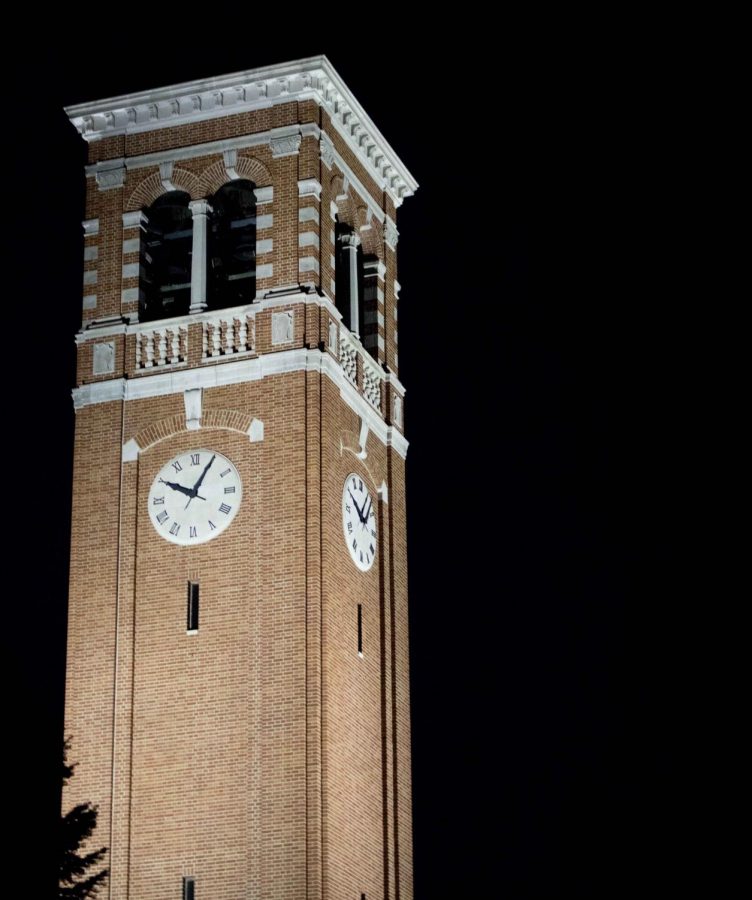The Campanile: a campus icon
Apr 9, 2018
Rising 100 feet into the sky and leaving Rod Library in its shadow, the Campanile is the most visible structure on UNI’s campus.
The Campanile serves a unique and symbolic role on campus. Since 2015, it has served as the gathering place for everything from a gun walkout demonstration to a candlelight vigil after a student suicide. Couples also share kisses during Homecoming at the base of the Campanile, a tradition dating back to the 1940’s.
History
According to the Rod Library archives, the Campanile’s physical structure was completed in 1926, but the project’s origins date back to 1914. Fundraising for the Campanile began in 1915 but was halted by the economic demands of World War I. It was initially estimated to cost $12,000, but costs rose to $40,000 by 1921, according to reporting from The College Eye, the student newspaper on campus at the time.
Fundraising efforts were slowed further by the 1920 recession. By 1924, cash donations and pledges totaled $20,500, and ground was broken that November. The dedication ceremony on September 19, 1926 was attended by 12,500 people, as estimated by The College Eye.
One of the most iconic parts of walking across campus at UNI is the sounds of the bells of the Campanile.
The Campanile’s bells are an instrument, located at the top of the tower, called the carillon. It has been used to perform songs and concerts since its installment in 1927, according to Rod Library. Recently, however, there have been concerns raised about the Campanile’s safety and the termination of public visits.
Safety Concerns
The Guild of Carillonneurs (GOC) is a student organization whose goal is to carry on the tradition of carillon performances, according to their mission statement. Tommy Truelsen, their president, said he feels more needs to be done to ensure safety for carillonneurs.
“The guardrail is one of the bigger safety issues,” Truelsen said. “It’s a very narrow staircase, and the distance between the rungs on the guardrail are large enough that I could fit through it; that concerns me.”
The Campanile’s stairway has existed in its current state since the Campanile’s completion in 1926, according to Michael Zwanziger, the director of facilities management.
Photographs provided by Abbie Greene, a member of the GOC and sophomore music technology major, show the large gaps in the handrail and rusting supports of the metal stairway.
After traversing the stairs, students climb a small ladder through a crawlspace to reach the platform supporting the carillon.
Other safety concerns include the lack of a fire extinguisher and smoke detectors at the top of the Campanile, near the heaters.
Truelsen approached fire safety about the issue, but they would not fund a second extinguisher. The UNI physical plant told Truelsen major renovations would be required to ensure a second safety exit.
As a last resort, all 13 members of the GOC went to the office of Danielle Massey, the Northern Iowa Student Government (NISG) Director of Finance. The Guild met with Massey to explain their concerns and ask what remedy may be available through contingency funding.
A budget request submitted to NISG reportedly states that the Guild asked for $372.86 for a fire extinguisher, two smoke detectors and an escape ladder. According to Massey, NISG funds cannot be used to fund fire safety items, so the request was denied.
What are seen as safety concerns by the GOC are part of the reason why the Campanile has been closed to public tours for three years.
According to Zwanziger, there are no questions about the physical integrity of the Campanile itself, nor should students be concerned about their personal safety.
“The Campanile meets the fire and building codes that are required for its type of use,” Zwanziger said in a phone interview. “There is a difference between what is required for a mechanical space and a public space.
“The reason it was closed to the public is because of the stairway,” Zwanziger added. “The stairway is safe to utilize for people playing the instrument or to do maintenance.”
Handrails are coded for safety training and safety equipment, according to Zwanziger. The GOC say the carillonneurs don’t receive any such training.
“It’s kind of strange that they have shut it down to the public but it’s still okay for us to be up there,” Truelsen said.
There have been no studies on the cost to repair the physical structure Campanile. The UNI Foundation is currently inquiring donors how much could be raised for a renovation before the Campanile’s 100th birthday in 2026, according to the Vice President of University Advancement Lisa Baronio.
The last work to repair the Campanile was done in 1995 to repair exterior bricks and add pavement to the base of the structure, according to the Rod Library archives. Before the Campanile was closed to the public, students and staff would give guided tours, a tradition dating back to 1942.
Just before it’s closure, the GOC would give tours whenever they were playing the carillon, according to Truelsen.
“I’ll never forget giving tours to the alumni of the UNI Varsity Men’s Glee Club a few years ago,” Truelsen reminisced. “It was great to hear their stories about the impact that the Campanile and carillon had on their college experience.”
“It’s one of the most memorable images from visiting UNI,” Truelsen added. “The tower offers an incredible instrument and beautiful view for the community to experience.”
Future Action
Various students have expressed their opinions about what action the university should take to repair and upgrade the Campanile.
“Allowing the Campanile to fall into disrepair is simply not acceptable,” said Oliverio Covarrubias, a senior psychology major. “Sure, the Campanile is just a building […] but it’s very clearly something that is UNI.”
“Since the Campanile will soon be 100 years old, it is important to restore the interior to its former brilliance,” said John Valentine, associate provost for faculty in the School of Music. “The music that emanates from the Campanile is incredible, and the views of campus from the top are absolutely stunning.”
The carillon’s condition is also suffering as a result of the deteriorating and outdated condition of the Campanile’s electrical work.
“The instrument room is not air conditioned and has some pretty antiquated heating systems,” said Lydia Richards, director of public relations for the GOC. “If we could get air conditioning, the instrument would last longer because there would not be drastic temperature and humidity changes.”
According to a 2006 study, the cost to refurbish the carillon was $213,000. John Funderburk, the director of the School of Music, said this figure would likely be much higher if a new study was done today. The current maintenance and repair fund contains just $47,387, according to Funderburk.
However, not all students are convinced of the importance of using school funds on the repair.
“I think it’s time we move on and find something that represents us in a unique way,” said Amela Music, a sophomore business economics major. “It’s not a really big focal point at this university; even the noise it makes is kind of a nuisance.”
The Campanile’s significance goes beyond being the placeholder for a unique and antiquated instrument, according to President Nook.
“The solid granite base of the Campanile is much like the education one receives at UNI,” President Nook said in an email. “It provides the solid foundation upon which the Campanile reaches into the sky and counts the passing of time.”
“It’s literally on the logo, on course packets from Copyworks, on advertisements, the website — you name it,” Richards said. “UNI is immediately associated with the Campanile and vice versa.”
The carillon itself has significance reaching beyond the historic value of its machinery. UNI’s carillon is one of only two in the state of Iowa. The other is located in the Campanile on Iowa State Univeristy’s campus.
“The Carillon provides the music that touches all of campus,” Nook said. “It enhances our lives by its presence.”









